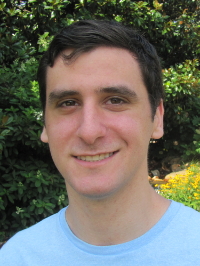2018 SRE Program Participant Profiles: Benjamin Schenck
 |
Hometown: Richmond, VA
|
Why did you apply to the SRE program?
While I have learned many useful mathematical and biological tools in the classroom, I had not yet applied this knowledge to a formal research project. By applying to NIMBioS, I was hoping to learn how to solve real-world problems as well as gain the skills necessary to feel comfortable doing more research in the future.
What is the purpose of your research?
My team's project involves forecasting the spread of a deadly disease affecting black walnut trees called thousand cankers disease. This disease is transmitted into the trees via a fungus carried by walnut twig beetles. Until recently, this disease was only thought present in the western United States. However, in 2010, the disease was detected in Knoxville, Tennessee, and has since been spotted in several other states along the eastern U.S. Our team's task is to use the known occurrences (in geographic coordinates) of both walnut twig beetles and black walnut trees, and use these areas to predict where the two species will be present in eastern U.S. under several different future climate models. We are then analyzing these regions where the species are predicted to overlap in order to predict the areas where the disease might be present in the future.
![]()
My favorite part of the SRE program has to be the accessibility of resources at NIMBioS. At any point, I could knock on a door and have a conversation with a researcher or professor about anything.
![]()
– Benjamin Schenck, SRE participant
What does the research ultimately accomplish? What contributions to science and/or humanity does the research ultimately make?
The end goal of this project is to understand how widespread thousand cankers disease could be in the future under climate change. By using ecological niche modeling, we will have geographic output to help scientists and the U.S. Forest Service target areas for prevention efforts. This could have a huge impact on saving the walnut trees.
Describe a typical day on the job.
Our group usually starts the day in the Spatial Analysis Lab. The work we do can vary from collecting geo-referenced data from databases and scientific literature, using a GIS software to overlay the data on a map and add layers for different climate models, to running a program called "Maxent," which uses all of our organized and prepared data to project the future niches of the species, and much more. The great part of this research experience is that there is no real "typical day." Sometimes all of the groups will meet together for a talk about preparing for post-college life. One day we all took a trip to the Knoxville Zoo. Another time our mentors took our group out to the field to show us how they deploy a drone to gather data and images. There was never a dull moment at NIMBioS!
Tell us something about your field of study we would be surprised to know.
As somebody interested in a statistics/data science career, I think the most surprising thing to people is the sheer number of options available to you. Every single company and public agency uses statistics in their day-to-day tasks. You could study pure statistics and go into academia, you could do the business end of things and study analytics, you could do what our group is doing here and work with geospatial data and geographic information systems. The possibilities are nearly endless and there will always be some avenue that suits your interests.
What were your favorite parts of the SRE program?
My favorite part of the SRE program has to be the accessibility of resources at NIMBioS. At any point, I could knock on a door and have a conversation with a researcher or professor about anything. Not only that, but they would occasionally take us out to lunch and offer us advice and answer our questions about graduate school, career paths, and more.
What new experiences did you gain that have helped you today?
I have learned many valuable skills during my time here. First, I have learned how to work efficiently in a small group. We learned when to work on tasks together and when to split things up, and we also learned when to take breaks and when to keep going. Also, I have learned several tools in this project that will help me for future research in the field. I have gotten extensive experience in ARCMap and Maxent, software which can help accomplish almost anything related to spatial data analysis.
What advice would you give someone who's interested in/curious about participating in the program?
The most important piece of advice I can give is to take full advantage of the resources provided to you. Talk to the mentors and ask about their research, schedule an appointment with a director in your field of interest at UT, and absorb all of the information that NIMBioS gives you about navigating life after college.
Would you recommend our program to others?
Yes, learning how to do a formal research project is some of the most valuable and enjoyable experience you can receive.
Where do you see yourself in 10 years?
After taking part in this program, I really think I'd like to pursue a master's or Ph.D. and be a researcher in the field of biostatistics. I think that data analysis is a very rewarding field, especially when it can be applied to helping solve biological problems.
Related Links
Main SRE page
2018 Summer Program
NIMBioS
1122 Volunteer Blvd., Suite 106
University of Tennessee
Knoxville,
TN 37996-3410
PH: (865) 974-9334
FAX: (865) 974-9461
Contact NIMBioS


